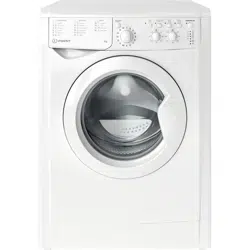Documents: Go to download!
User Manual
- User Manual - (English)
- CLEANING & MAINTENANCE - (English)
- Health Safety Environmental - (English)
- New Energy Label - (English)
- Product Information Sheet - (English)
- Nel Data Sheet - (English)
- Spec Sheet (web) - (English)
- Quick Guide - (English)
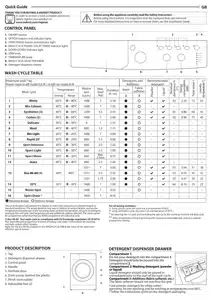
- Description of the washing machine and starting a wash cycle
- WASH CYCLE TABLE
- PRODUCT DESCRIPTION
- DETERGENT DISPENSER DRAWER
- WASH CYCLES
- INDICATOR LIGHTS
- DOOR LOCKED INDICATOR
- FIRST-TIME USE
- DAILY USE
- PAUSING A CYCLE
- OPENING THE DOOR, IF NECESSARY
- CHANGING A RUNNING WASH CYCLE
- END OF THE CYCLE
- OPTIONS
- TIPS AND SUGGESTIONS
- CARE AND MAINTENANCE
- LOAD BALANCING SYSTEM
- ACCESSORIES
- TRANSPORT AND HANDLING
- TROUBLESHOOTING
Table of contents
Instructions for use WASHING MACHINE
Description of the washing machine and starting a wash cycle
Control panel
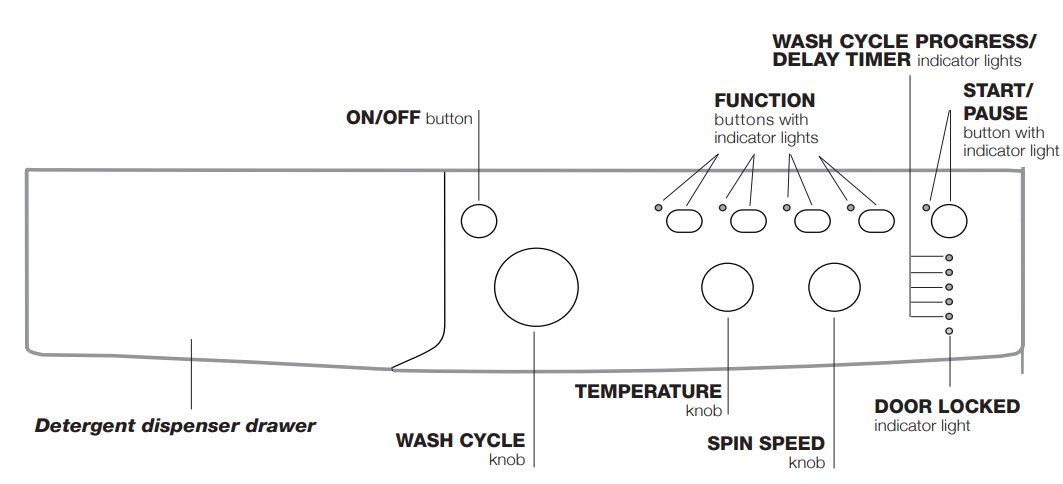
Detergent dispenser drawer: used to dispense detergents and washing additives (see “Detergents and laundry”).
ON/OFF button: switches the washing machine on and off.
WASH CYCLE knob: programmes the wash cycles. During the wash cycle, the knob does not move.
FUNCTION buttons with indicator light: used to select the available functions. The indicator light corresponding to the selected function will remain lit.
TEMPERATURE knob: sets the temperature or the cold wash cycle (see “Personalisation”).
SPIN SPEED knob: sets the spin speed or exclude the spin cycle completely (see “Personalisation”).
WASH CYCLE PROGRESS/DELAY TIMER indicator lights: used to monitor the progress of the wash cycle. The illuminated indicator light shows which phase is in progress.
If the Delay Timer function has been set, the time remaining until the wash cycle starts will be indicated (see next page).
DOOR LOCKED indicator light: indicates whether the door may be opened or not (see next page).
START/PAUSE button with indicator light: starts or temporarily interrupts the wash cycles.
N.B. To pause the wash cycle in progress, press this button; the corresponding indicator light will flash orange, while the indicator light for the current wash cycle phase will remain lit in a fixed manner. If the DOOR LOCKED indicator light is switched off, the door may be opened (wait approximately 3 minutes).
To start the wash cycle from the point at which it was interrupted, press this button again.
Standby mode
This washing machine, in compliance with new energy saving regulations, is fitted with an automatic standby system which is enabled after about 30 minutes if no activity is detected. Press the ON-OFF button briefly and wait for the machine to start up again.
Indicator lights
The indicator lights provide important information. This is what they can tell you:
Delayed start
If the DELAY TIMER function has been activated (see “Personalisation”), after the wash cycle has been started the indicator light corresponding to the selected delay period will begin to flash: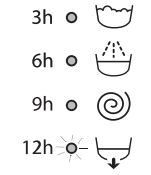
As time passes, the remaining delay will be displayed and the corresponding indicator light will flash: 
The set programme will start once the selected time delay has expired.
Wash cycle phase indicator lights
Once the desired wash cycle has been selected and has begun, the indicator lights switch on one by one to indicate which phase of the cycle is currently in progress.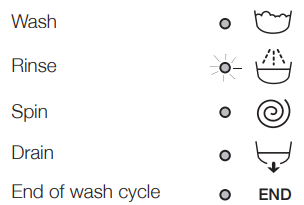
Function buttons and corresponding indicator lights
When a function is selected, the corresponding indicator light will illuminate.
If the selected function is not compatible with the programmed wash cycle, the corresponding indicator light will flash and the function will not be activated.
If the selected function is not compatible with another function which has been selected previously, the indicator light corresponding to the first function selected will flash and only the second function will be activated; the indicator light corresponding to the enabled option will remain lit.
Door locked indicator light
When the indicator light is on, the porthole door is locked to prevent it from being opened; make sure the indicator light is off before opening the door (wait approximately 3 minutes). To open the door during a running wash cycle, press the START/PAUSE button; the door may be opened once the DOOR LOCKED indicator light turns off.
Starting a wash cycle
- Switch the washing machine on by pressing the ON/OFF button. All indicator lights will switch on for a few seconds, then they will switch off and the START/PAUSE indicator light will pulse.
- Load the laundry and close the door.
- Set the WASH CYCLE knob to the desired programme.
- Set the washing temperature (see “Personalisation”).
- Set the spin speed (see “Personalisation”).
- Measure out the detergent and washing additives (see “Detergents and laundry”).
- Select the desired functions.
- Start the wash cycle by pressing the START/PAUSE button and the corresponding indicator light will remain lit in a fixed manner, in green. To cancel the set wash cycle, pause the machine by pressing the START/PAUSE button and select a new cycle.
- At the end of the wash cycle the END indicator light will switch on. The door can be opened once the DOOR LOCKED indicator light turns off (wait approximately 3 minutes). Take out your laundry and leave the appliance door ajar to make sure the drum dries completely. Switch the washing machine off by pressing the ON/OFF button.
WASH CYCLE TABLE

The cycle duration indicated on the display or instruction manual is an estimate based on standard conditions. The actual duration may vary in relation to several factors, such as the temperature and pressure of the incoming water, ambient temperature, amount of detergent, load quantity and type, load balancing and any additional options selected. The values given for programmes other than the Eco 40-60 programme are indicative only.
1) Eco 40-60 - Test wash cycle in compliance with EU Ecodesign regulation 2019/2014.
The most efficient programme in terms of energy and water consumption for washing normally soiled cotton laundry. Note: for the Eco 40-60 program in the WASH CYCLE TABLE the value of the maximum effective spin is shown.
For all testing institutes:
2) Long cotton cycle: set cycle 4 at a temperature of 40°C.
3) Long synthetics cycle: set cycle 3 at a temperature of 40°C.
* By selecting the 16 cycle and excluding the spin cycle, the washing machine will drain only.
** After programme end and spinning with maximum selectable spin speed, in default programme setting.
PRODUCT DESCRIPTION

1. Top
2. Detergent dispenser drawer
3. Control panel
4. Handle
5. Porthole door
6. Drain pump (behind the plinth)
7. Plinth (removable)
8. Adjustable feet (2)
DETERGENT DISPENSER DRAWER
Detergent dispenser drawer
Good washing results also depend on the correct dose of detergent: adding too much detergent will not necessarily result in a more efficient wash, and may in fact cause build up on the inside of your appliance and contribute to environmental pollution.
! Do not use hand washing detergents because these create too much foam.
! Use powder detergent for white cotton garments, for prewashing, and for washing at temperatures over 60°C.
! Follow the instructions given on the detergent packaging.
Open the detergent dispenser drawer and pour in the detergent or washing additive, as follows.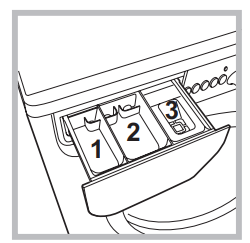
! Do not put the detergent into compartment 1.
! The detergent must be put only in the compartment 2.
compartment 2: Detergent for the wash cycle (powder or liquid)
Liquid detergent should only be poured in immediately prior to the start of the wash cycle.
compartment 3: Additives (fabric softeners, etc.)
The fabric softener should not overflow the grid.
Note: If a “tablet detergent” is used, always follow the manufacturer’s instructions.
Preparing the laundry
- Divide the laundry according to: - the type of fabric/the symbol on the label - the colours: separate coloured garments from whites.
- Empty all garment pockets and check the buttons.
- Do not exceed the values listed in the “Table of wash cycles”, which refer to the weight of the laundry when dry.
How much does your laundry weigh?
1 sheet 400-500 g
1 pillow case 150-200 g
1 tablecloth 400-500 g
1 bathrobe 900-1200 g
1 towel 150-250 g
Garments requiring special care
Wool: all wool garments can be washed using programme 3, even those carrying the “hand-wash only”  label. For best results, use special detergents and do not exceed 1.5 kg of laundry.
label. For best results, use special detergents and do not exceed 1.5 kg of laundry.
Baby: cycle designed for dirt typical of children’s garments in that it effectively removes any traces of residual detergent.
Silk: use special wash cycle 6 to wash all silk garments. We recommend the use of special detergent which has been designed to wash delicate clothes.
Curtains: fold curtains and place them in a pillow case or mesh bag. Use wash cycle 6.
Duvet: to wash single duvets (the weight of which should not exceed 1.5 kg), cushions or clothes padded with goose down such as puffa jackets, use the special wash cycle number 7. We recommend that duvets are placed in the drum with their edges folded inwards (see figure) and that no more than ¾ of the total volume of the drum is used. To achieve the best results, we recommend that a liquid detergent is used and placed inside the detergent dispenser drawer.

Sanitary (wash cycle 8). A high-temperature hygienic wash cycle (over 60°C) for extremely soiled whites.
Sport Kit: a cycle designed to simultaneously wash any type of sports clothing together with gym towels (Temperature 40°).
Sport Shoes: is for washing sports shoes; for best results, do not wash more than 2 pairs simultaneously. We recommend fastening any strings before introducing the shoes into the drum.
Technical Wear: designed for specifically washing waterproof garments or clothing with special technical fibres like Gore-Tex, so as to optimise washing performance while preserving their technical properties over time. Do not use fabric softeners for garments with technical fibres.
Load balancing system
Before every spin cycle, to avoid excessive vibrations and to distribute the load in a uniform manner, the drum rotates continuously at a speed which is slightly greater than the washing rotation speed. If, after several attempts, the load is not balanced correctly, the machine spins at a reduced spin speed. If the load is excessively unbalanced, the washing machine performs the distribution process instead of spinning. To encourage improved load distribution and balance, we recommend small and large garments are mixed in the load.
WASH CYCLES
Follow the instructions on the symbols of the garment’s wash care label. The value indicated in the symbol is the maximum recommended temperature for washing the garment.

White
extremely soiled whites.
Mix Colours
A 40°C cycle that helps to preserve colours, suitable for cotton or synthetic coloured garments. It allows for reducing electricity consumption for heating the water while guaranteeing good washing results. Suitable for lightly soiled garments.
Synthetics
Specific for synthetic items. If the dirt is difficult to remove, the temperature can be increased up to 60° and powder detergent can be used too.
Cotton
Suitable for washing towels, underwear, table cloths, etc. made of resistant linen and cotton that are moderately to heavily soiled.
Delicate
use programme 5 to wash very delicate garments. It is advisable to turn the garments inside out before washing them. For best results, use liquid detergent on delicate garments.
Wool
all wool garments can be washed using programme 6, even those carrying the “hand-wash only”  label. For best results, use special detergents and do not exceed 1.5 kg of laundry.
label. For best results, use special detergents and do not exceed 1.5 kg of laundry.
Mix Light
ideal for mixed loads (cotton and synthetics) with a normal soil level. The effective performance levels achieved at cold temperatures are guaranteed by a mechanical action which operates at varying speed, across set average intervals.
Rapid 20’
ideal for refreshing and washing lightly soiled garments in a few minutes. It lasts just 20 minutes and therefore saves both time and energy. It can be used to wash different types of fabrics together (except for wool and silk), with a maximum load of 1.5 kg.
Sport Intensive
is for washing heavily soiled sports clothing fabrics (tracksuits, shorts, etc.); for best results, we recommend not exceeding the maximum load indicated in the “Wash Cycle Table”.
Sport Light
is for washing lightly soiled sports clothing fabrics (tracksuits, shorts, etc.); for best results, we recommend not exceeding the maximum load indicated in the “Wash Cycle Table”. We recommend using a liquid detergent and dosage suitable for a half-load.
Sport Shoes
is for washing sports shoes; for best results, do not wash more than 2 pairs simultaneously.
Jeans
Turn garments inside-out before washing and use a liquid detergent.
Eco 40-60
For washing normally soiled cotton garments declared to be washable at 40 °C or 60 °C, together in the same cycle. This is the standard cotton programme and the most efficient in terms of water and energy consumption.
20°C
For washing lightly soiled cotton garments, at a temperature of 20 °C.
Rinse+Spin
designed for rinsing and spinning.
Spin+Drain
designed to spin and drain the water.
INDICATOR LIGHTS
The indicator lights provide important information. This is what they can tell you:
Delayed start
If the DELAY TIMER function has been activated, after the wash cycle has been started the indicator light corresponding to the selected delay period will begin to flash:

As time passes, the remaining delay will be displayed and the corresponding indicator light will flash:

The set programme will start once the selected time delay has expired.
Wash cycle phase indicator lights
Once the desired wash cycle has been selected and has begun, the indicator lights switch on one by one to indicate which phase of the cycle is currently in progress.

 DOOR LOCKED INDICATOR
DOOR LOCKED INDICATOR
When lit, the symbol indicates that the door is locked. To prevent any damage, wait until the symbol turns off before opening the door. To open the door while a cycle is in progress, press the START/PAUSE button ; if the
; if the  symbol is off, the door can be opened.
symbol is off, the door can be opened.
FIRST-TIME USE
Once the appliance has been installed, and before it is used for the first time, run a wash cycle with detergent and no laundry, by setting the “1” cycle.
DAILY USE
Prepare the laundry by following the suggestions appearing under the “TIPS AND SUGGESTIONS” section.
- Press the ON/OFF button ; the START/PAUSE indicator light
button ; the START/PAUSE indicator light  will flash slowly green.
will flash slowly green.
- Open the door. Load the laundry while making sure not to exceed the maximum load quantity indicated in the Wash Cycle Table.
- Pull out the detergent dispenser drawer and pour the detergent into the relevant compartments as described in “DETERGENT DISPENSER DRAWER” section.
- Close the door.
- Select the desired wash cycle.
- Set the washing temperature.
- Set the spin speed.
- Select the desired options.
- Press the START/PAUSE button to start the wash cycle; the relative indicator light will light up steady green and the door will lock (
button to start the wash cycle; the relative indicator light will light up steady green and the door will lock (  symbol on).
symbol on).
PAUSING A CYCLE
To pause the wash cycle, press the START/PAUSE button again; the indicator light will flash amber. If the
button again; the indicator light will flash amber. If the  symbol is not lit, the door may be opened. To start the wash cycle from the point at which it was interrupted, press the START/PAUSE
symbol is not lit, the door may be opened. To start the wash cycle from the point at which it was interrupted, press the START/PAUSE button again.
button again.
OPENING THE DOOR, IF NECESSARY
Once a cycle starts, the  symbol turns on to signal that the door cannot be opened. While a wash cycle is running, the door remains locked. To open the door while a cycle is under way, for example, to add or remove garments, press the START/PAUSE
symbol turns on to signal that the door cannot be opened. While a wash cycle is running, the door remains locked. To open the door while a cycle is under way, for example, to add or remove garments, press the START/PAUSE  button to pause the cycle; the indicator light will flash amber. If the
button to pause the cycle; the indicator light will flash amber. If the symbol is not lit, the door may be opened. Press the START/PAUSE
symbol is not lit, the door may be opened. Press the START/PAUSE button again to continue the cycle.
button again to continue the cycle.
CHANGING A RUNNING WASH CYCLE
To change a wash cycle while it is in progress, pause the washing machine using the START/PAUSE button (the relative indicator light will flash amber), then select the desired cycle and press the START/PAUSE
button (the relative indicator light will flash amber), then select the desired cycle and press the START/PAUSE button again.
button again.
- To cancel a cycle that has already begun, press and hold the ON/OFF
 button. The cycle will be stopped and the machine will switch off.
button. The cycle will be stopped and the machine will switch off.
END OF THE CYCLE
Once the cycle terminates the END indicator light will light up; when the  indicator light switches off, the door may be opened. If you do not press ON/OFF
indicator light switches off, the door may be opened. If you do not press ON/OFF button, the washing machine will switch off automatically after about a 10 minutes. Close the water tap, open the door and unload the washing machine. Leave the door ajar to allow the drum to dry
button, the washing machine will switch off automatically after about a 10 minutes. Close the water tap, open the door and unload the washing machine. Leave the door ajar to allow the drum to dry
OPTIONS
- If the selected function is not compatible with the programmed wash cycle, the corresponding indicator light will flash and the function will not be activated.
- If the selected function is not compatible with another function which has been selected previously, the indicator light corresponding to the first function selected will flash and only the second function will be activated; the indicator light corresponding to the enabled option will remain lit.
Time Saver
Selecting this option enables you to suitably adjust drum rotation, temperature and water to a reduced load of lightly soiled cotton and synthetic fabrics. Time Saver enables you to wash in less time thereby saving water and electricity. We suggest using a liquid detergent suitably measured out to the load quantity.

The  function saves energy by not heating the water used to wash your laundry - an advantage both to the environment and to your energy bill. Instead, intensified wash action and water optimisation ensure great wash results in the same average time of a standard cycle. For the best washing results we recommend the usage of a liquid detergent.
function saves energy by not heating the water used to wash your laundry - an advantage both to the environment and to your energy bill. Instead, intensified wash action and water optimisation ensure great wash results in the same average time of a standard cycle. For the best washing results we recommend the usage of a liquid detergent.
Extra Rinse
By selecting this option, the efficiency of the rinse is increased and optimal detergent removal is guaranteed. It is particularly useful for sensitive skin.
Delay Timer
This timer delays the start time of the wash cycle by up to 12 hours. Press the button repeatedly until the indicator light corresponding to the desired delay time switches on. The fifth time the button is pressed, the function will be disabled.
N.B. Once the START/PAUSE button has been pressed, the delay time can only be modified by decreasing it until launching the set programme.
button has been pressed, the delay time can only be modified by decreasing it until launching the set programme.
Temperature
Turn the TEMPERATURE knob to set the wash temperature (see Wash Cycle Table).
The temperature may be lowered, or even set to a cold wash .
.
The washing machine will automatically prevent you from selecting a temperature which is higher than the maximum value set for each wash cycle.
Spin
Turn the SPIN SPEED knob to set the spin speed for the selected wash cycle.
The spin speed may be lowered, or the spin cycle can be excluded altogether by selecting the symbol  .
.
The washing machine will automatically prevent you from selecting a spin speed which is higher than the maximum speed set for each wash cycle.
TIPS AND SUGGESTIONS
Divide the laundry according to:
Type of fabric (cotton, mixed fibres, synthetics, wool, garments to be hand-washed). Colour (separate coloured garments from whites, wash new coloured garments separately). Delicates (small garments – such as nylon stockings – and items with hooks – such as bras: insert them in a fabric bag).
Empty the pockets:
Objects such as coins or lighters can damage the washing machine and the drum. Check all buttons.
Follow the dosage recommendation / additives
It optimizes the cleaning result, it avoids irritating residues of surplus detergent in your laundry and it saves money by avoiding waste of surplus detergent.
Use low temperature and longer duration
The most efficient programmes in terms of energy consumption are generally those that perform at lower temperatures and longer duration.
Observe the load sizes
Load your washing machine up to the capacity indicated in the "Wash Cycle Table” table to save water and energy.
Noise and remaining moisture content
They are influenced by the spinning speed: the higher the spinning speed in the spinning phase, the higher the noise and the lower the remaining moisture content.
CARE AND MAINTENANCE
Before performing cleaning and maintenance, switch the washing machine off and disconnect it from the mains power. Do not use flammable liquids to clean the washing machine. Clean and maintain your washing machine periodically (at least 4 times per year).
Cutting off the water and electri- city supplies
- Turn off the water tap after every wash cycle. This will limit wear on the hydraulic system inside the washing machine and help to prevent leaks.
- Unplug the washing machine when cleaning it and during all maintenance work.
Clean the washing machine
The outer parts and rubber components of the appliance can be cleaned using a soft cloth soaked in lukewarm soapy water. Do not use solvents or abrasives.
Clean the detergent dispenser drawer
Remove the dispenser by raising it and pulling it out (see figure). Wash it under running water; this operation should be repeated frequently.
Care for the door and drum
- Always leave the porthole door ajar in order to prevent unpleasant odours from forming.
Clean the pump
The washing machine is fitted with a self-cleaning pump which does not require any maintenance. Sometimes, small items (such as coins or buttons) may fall into the pre-chamber which protects the pump, situated in its bottom part.
! Make sure the wash cycle has finished and unplug the appliance. To access the pre-chamber:
To access the pre-chamber:
- using a screwdri- ver, remove the cover panel on the lower front part of the wa- shing machine (see figure);
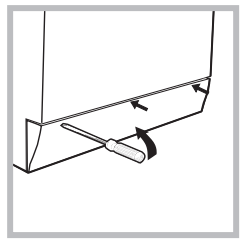
- unscrew the lid by rotating it anticlockwise (see figu- re): a little water may trickle out. This is perfectly normal;
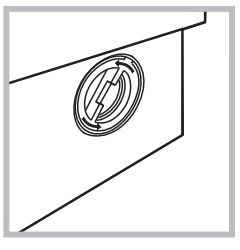
- clean the inside thoroughly;
- screw the lid back on;
- reposition the panel, making sure the hooks are securely in place before you push it onto the appliance.
Check the water inlet hose
Check the water inlet hose at least once a year. If it is cracked or broken, it must be replaced: during wash cycles, the high pressure of the water could suddenly split the hose open.
- Never use hoses that have already been used
LOAD BALANCING SYSTEM
Before every spin cycle, to avoid excessive vibrations before every spin and to distribute the load in a uniform manner, the drum rotates continuously at a speed which is slightly greater than the washing rotation speed. If, after several attempts, the load is not balanced correctly, the machine spins at a reduced spin speed. If the load is excessively unbalanced, the washing machine performs the distribution process instead of spinning. To encourage improved load distribution and balance, we recommend small and large garments are mixed in the load.
ACCESSORIES
Contact our Technical Assistance Service to check whether the following accessories are available for this washing machine model.
Stacking kit
With this accessory you can secure the tumble dryer to the upper part of your washing machine to save space and facilitate loading and unloading of the tumble dryer
TRANSPORT AND HANDLING
Do not lift the washing machine by gripping it from the upper section. Unplug the appliance and close the water tap. Check that the door and detergent dispenser drawer are tightly closed. Detach the filling hose from the water tap then detach the drain hose. Empty all the water remaining in the hoses and secure the latter so that they do not get damaged during transport. Apply the transport bolts back on. Repeat, in reverse order, the transport bolt removal procedure described in the “Health & Safety and Installation Guides”.
TROUBLESHOOTING
The washing machine may occasionally fail to work. Before contacting the Technical Assistance Service, make sure that the problem cannot be easily solved using the following list.
| Problem: | Possible causes / Solutions: |
| The machine does not switch on | The appliance is not plugged into the socket fully, or not enough to make contact |
| There is no power to the socket, or the fuse has blown in the mains plug. | |
| The wash cycle does not start. | The washing machine door is not closed properly. |
The ON/OFF button has not been pressed. button has not been pressed. | |
The START/PAUSE button has not been pressed. button has not been pressed. | |
| The water tap has not been turned on to allow water to flow into the machine. | |
| A delay has been set for the start time. | |
| The machine does not fill with water or the indicator light for the first wash cycle stage flashes rapidly. | The water inlet hose is not connected to the tap. |
| The hose is bent. | |
| The water tap has not been opened. | |
| There is no water supply in the house. | |
| The pressure is too low. | |
The START/PAUSE button has not been pressed. button has not been pressed. | |
| The machine continuously fills with water and continually drains away or Water left in the drum or Stuck on wash. | The top of the drain hose is too low - It must be fitted at a height between 65 and 100 cm from the floor (see “Installation”). |
| The drain hose is connected incorrectly to the sink trap allowing water to run into the machine, the drain hose must be positioned higher than the bottom of the sink to prevent water flowing down the drain hose. | |
| The end of the drain hose has been pushed too far down the standpipe, the ‘U’ bracket should be fitted 100 mm from the end of the drain hose. | |
| The washing machine does not drain or spin. | The Pump filter is blocked. |
| The drain hose is kinked (see “Installation”). | |
| New Installation - The blanking cap or spigot has not been removed if connected under a sink. | |
| The drain hose or sink trap is blocked. | |
| The wash cycle does not include draining, some wash cycles require the drain phase to be started manually. | |
The ‘Spin Speed’ selector knob is in the  position. position. | |
| The machine does not heat or poor wash results. | The ‘Temperature’ selector knob is in the “ ” position. ” position. |
| The programme takes too long. | Programme times will vary due to water pressure, the incoming water temperature and if the wash load goes out of balance. This will increase the programme times accordingly (see ‘ The machine wont spin properly’ next page). |
| The machine vibrates a lot during the spin cycle. | The feet have not been adjusted, enabling the machine to rock. |
| New Installation - Either the Transit Bolts including the plastic spacers, or the Polystyrene Packaging have not been removed when installing the machine. | |
| The load is in a slight out of balance condition and machine is spinning, but at a lower speed. | |
| The machine is trapped between cabinets and/or walls. | |
| The machine is noisy | There will always be some motor, pump and drum noise during spin. |
| The machine wont spin properly. | Out of Balance detected when attempting to go into a spin cycle - If this happens the machine will continue to try to repeat the distribution of the load required before the machine will go into higher spin speeds - This will increase the programme time accordingly. This is a safety feature to prevent damage. Out of Balance can be caused by washing a single heavy item (eg duvet, quilt, etc). - Try the programme again using a different load. |
| The machine leaks from the dispenser | The dispenser drawer is blocked with detergent and requires cleaning. |
| The water pressure is too high and requires turning down - turn down the tap on the water supply pipe slightly and try again. | |
| The machine is tilting forwards - It must be level when in its final position. | |
| The machine leaks (other than dispenser). | The fill hose is loose, check both the cabinet and tap ends. |
| The fill hose is tight but still leaks, if so replace the rubber washers, or the fill hose is missing the rubber washer. | |
| The drain hose is not fixed in properly. | |
| The indicator lights on the console are flashing rapidly. | Switch off the machine and unplug it, wait for approximately 1 minute and then switch it back on again If the problem persists contact the Technical Assistance Service. |
| The machine smells. | The machine requires a service wash. Run a 90 degree wash cycle with detergent and no laundry. |
| The machine door cannot be opened. | The door will not open until the door lock indicator light goes out shortly after the program has finished. |
| Door Seal damaged at the bottom | The door seal has drainage holes at the bottom - This is normal. |
| The water level is too low when the machine is washing. | The water level is correct if it can be seen at the bottom of the door. |
| There is too much foam. | The detergent is not suitable for machine washing (it should display the text ‘for washing machines’ or ‘hand and machine wash’ or the like). • |
| Too much detergent was used - less detergent is required in soft water. | |
| After completing the programme, or before starting a programme, the machine has turned itself off (no lights). | To comply with new energy saving regulations the machine is fitted with an automatic standby system. Press ‘ON/OFF’ button for 3 seconds to activate the machine, it can then either be switched off or a new programme selected. |
| General. | Your washing machine contains sensors that monitor progress during the wash cycle (eg: Water Levels, Temperatures, Out of Balance loads, Wash time/progress). Normally, if your machine successfully completes the cycle, there is unlikely to be anything wrong! |
Remember, you will be charged for a service call for problems caused by incorrect installation, as indicated on pages 2 to 4.
Not emptying contents from pockets may cause pump or drain blockages, or may damage the machine.
Do not wash items which do not have a wash label, or wash items that are not intended as machine washable.
See other models: F163733 F155231 F163715 F163407 F163409
